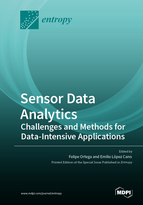Sensor Data Analytics: Challenges and Methods for Data-Intensive Applications
A special issue of Entropy (ISSN 1099-4300). This special issue belongs to the section "Signal and Data Analysis".
Deadline for manuscript submissions: closed (29 October 2021) | Viewed by 25752
Special Issue Editors
Interests: data science; data engineering; scalable machine learning; distributed computing; streaming data; information visualization; software engineering; open source software
Interests: applied statistics; computational statistics; statistical software; simulation; standards; statistical methods for quality control and improvement; open source software; machine learning; energy modelling
Special Issue Information
Dear Colleagues,
At present, data-intensive applications are one of the most prominent lines of work in data science. Most of these projects arise in the context of sensor data analytics, where different devices, equipment, and software applications provide dynamic datasets to be processed and analyzed with machine learning algorithms. Application domains span multiple areas, including smart cities and intelligent transport, economy and finance, energy management, biomedical applications, geographical systems, agriculture, and livestock or cybersecurity.
Hence, this Special Issue is focused on emerging challenges, methods, algorithms, and tools that address sensor data analytics, with a special emphasis on approaches that leverage information theory to accomplish projected goals. We strongly encourage practical applications following interdisciplinary approaches, using real-world data.
This Special Issue expects submissions on the use of data science and artificial intelligence on sensor data analytics, including but not limited to:
- Internet of Things and smart cities;
- Smart grids and smart meters;
- Cyberphysical systems in Industry 4.0;
- Biomedical engineering and bioinformatics;
- Remote sensing, geostatistics, and GIS;
- Precision agriculture and livestock;
- Environmental science data;
- Robotics, and autonomous mobility;
- Cybersecurity and biometric systems;
- Wearable devices.
Dr. Felipe Ortega
Dr. Emilio López Cano
Guest Editors
Manuscript Submission Information
Manuscripts should be submitted online at www.mdpi.com by registering and logging in to this website. Once you are registered, click here to go to the submission form. Manuscripts can be submitted until the deadline. All submissions that pass pre-check are peer-reviewed. Accepted papers will be published continuously in the journal (as soon as accepted) and will be listed together on the special issue website. Research articles, review articles as well as short communications are invited. For planned papers, a title and short abstract (about 100 words) can be sent to the Editorial Office for announcement on this website.
Submitted manuscripts should not have been published previously, nor be under consideration for publication elsewhere (except conference proceedings papers). All manuscripts are thoroughly refereed through a single-blind peer-review process. A guide for authors and other relevant information for submission of manuscripts is available on the Instructions for Authors page. Entropy is an international peer-reviewed open access monthly journal published by MDPI.
Please visit the Instructions for Authors page before submitting a manuscript. The Article Processing Charge (APC) for publication in this open access journal is 2600 CHF (Swiss Francs). Submitted papers should be well formatted and use good English. Authors may use MDPI's English editing service prior to publication or during author revisions.
Keywords
- Data science
- Artificial Intelligence
- Machine learning
- Sensor analytics
- Internet of Things
- Data mining
- Computational statistics
- Data-intensive applications
- Scalable algorithms
- Streaming data
- Information theory








